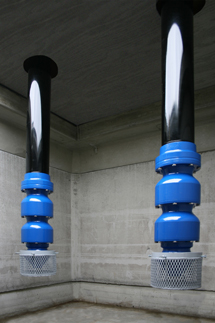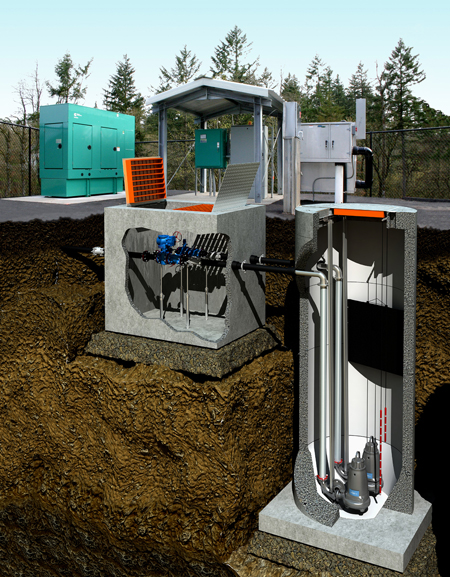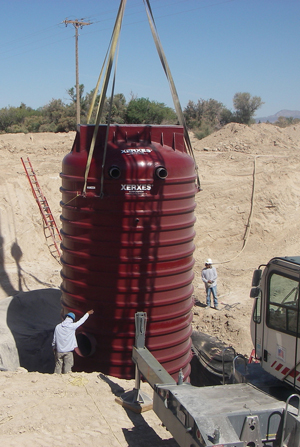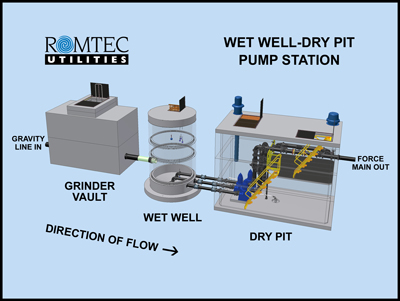Pump stations are an integral part of wastewater collection and treatment systems. Various applications include lift stations in the collection network pumping raw sewage up to a level where gravity can take over, and pumps in the treatment plant moving effluent through various treatment stages. While wastewater pumps have a common function--moving fluid where gravity cannot--the design of any individual pump station can depend on many factors.
Choosing the right pump station design for the application is a matter of balancing personal preference with the job's requirements.
Submersible Pump Systems: Municipal Favorites
Camas, Wash., is a town of 17,000 outside the Portland, Ore., metro area. To serve its growing population, the city's Public Works department has an aggressive program to update existing sewer infrastructure. In the last few years, Camas has replaced five wastewater pump stations and brought an equal number of new stations online.
All of the city's legacy pumping systems have been replaced with pre-engineered submersible pump lift stations. The submersible system consists of the underground wet well, equipped with submersible pumps, piping and liquid level sensors; the valve vault; the force main; the above-ground electrical control panel and a standby electrical generator.
Submersible lift stations are the dominant pumping system in the municipal market. They offer lower initial cost because only one pit is needed (compared to traditional dry pit-wet well installations). The stations generally have a smaller footprint, low operating cost and simplified operation and maintenance. Because the only above-ground structures are the control panel and backup generator, submersible pump lift stations tend to blend in with the surrounding environment-a plus for public relations.
Submersible wastewater pumps are vertical, direct-coupled, heavy duty centrifugal units, which operate underwater. The pumps offer high operating efficiencies. Most municipal lift stations require pumps that will pass a 2.25 in diameter sphere without clogging and have a minimum 3 in diameter discharge. Rather than using a single pump, most systems have multiple pumps in a duplex (two) or triplex (three) pump configuration. This provides redundancy, in case of a pump failure or clog.
Camas worked with a pump station manufacturer to procure complete sewage pumping systems with all components--structural, mechanical, electrical and communication--in one shipment, pretested and ready to install.
The complete systems, configured to meet Camas' requirements, allow the city to standardize its lift station network. "The stations are all very similar, and that allows our maintenance folks to work on them easily," explains Jim Hodges, the city's Capital Projects Manager. "They don't have to learn different telemetry for different stations. . . the same is true for the pumps."
Precast Wet Well-Dry Pit Systems: For Big Jobs
The recent expansion of a California military base's barracks meant a significant upgrade to the sewer infrastructure to handle increased flow and position the base for future growth. One of the key components of the construction project was a new pump station to move wastewater more than 1,000 ft to a gravity sewer.
Engineers for the project chose a wet well-dry pit pump station design. With this system, the pumps and valves are housed in an underground, easily accessible pump room-a "dry pit" made of precast concrete. The wet well, a separate vessel adjacent to the dry pit structure, is connected to the pumps via 8 in diameter suction lines. The wet well is lined with a PVC material embedded in the precast concrete to protect the concrete from the damaging effects of hydrogen sulfide.
In the California application, a precast concrete vault was added to the system to house an inline grinder that macerates tough solids before they enter the wet well. All three vessels-the dry pit, the wet well and the grinder vault-are accessible from the surface by maintenance personnel. Hatches in the tops of each are equipped with fall protection.
The wet well-dry pit system is common for pumping applications that require large pumps to move large sewage flows. A wet-dry system allows for much higher design flow capacity, since the dry pit housing the pumps is not limited in size or shape, unlike a round or rectangular wet well made of precast concrete or fiberglass.
Engineers for the California project chose a packaged lift station that came to the site pretested and ready to assemble. The base of the 16-ft-deep dry pit, for example, came preassembled with three 15 hp pumps mounted to custom-designed stands. Three precast concrete riser sections were added, plus the top, making a completely encased dry pit featuring an OSHA-approved staircase and internal platform for access to pumps, valves and flowmeters.
The California project called for the use of submersible pumps in the dry pit application. "That's becoming a very popular feature in wet well-dry pit systems," says Mark Sheldon of Romtec Utilities, which supplied the system. "Even though it may be sealed, an underground dry pit still has the potential to become flooded. Installing submersible pumps is a good way to safeguard your investment."
Short-Set Line-shaft Vertical Turbine Pump Systems: An Efficient Solution
Originally designed for deep water wells, vertical turbine pumps with short line shafts have been adapted for use in municipal and industrial applications. In wastewater treatment plants, where the effluent does not contain large solids, short-set line-shaft vertical turbine pumps have become commonplace. Although they are not designed to handle solids, turbine pumps are efficient; line shaft turbine systems can reach pump efficiencies more than 75 percent, and commonly run in the 80 to 85 percent range.
Unlike submersible pumps, they are not designed to handle solids. For this reason, vertical turbine pump systems are commonly used to move large volumes of effluent in wastewater treatment plants, and they are the pumps of choice for delivering treated effluent for reuse in irrigation and other applications. Vertical turbine pumps are also efficient solutions in industrial applications where water used in various processes must be moved in volume--and quickly--from one part of an industrial site to another; in or out of filtration, treatment and reuse; or to storage tanks or industrial wastewater lagoons.
Like submersible pumps, the submerged impellers of vertical turbines allow the pump to be started without priming. Multiple impellers, each within its own matching bowl, are assembled on the line shaft, making it possible to custom design the pump performance to match the specific duty. The fact that the vertical turbine pump can be multistaged allows a great deal of flexibility, both in the initial pump selection and if future system modifications require a change in the pump rating.
In a vertical turbine pump station, two or more pumps are mounted through the top slab of the round or rectangular wet well, with the impellers reaching nearly to the bottom of the well. The suction bell at the bottom of the pump assembly is typically fitted with a strainer to prevent solids and large grit from entering the pump. Depending on the application, there may be additional screening in the influent line to the wet well, simply to ensure that no large solids are sucked in the pumps.
The pump heads and motors, along with piping, valves and controls are usually located above ground, and they may be inside a building or shelter for protection from freezing. Liquid level sensors, usually micro-switch floats hung in the wet well, provide the necessary pump start-and-stop information to the control panel.
Conclusion
Submersible pump stations, wet well-dry-pit pump stations and vertical turbine pump stations all have a place in moving wastewater. The types of pump stations used in various wastewater applications can be quite varied, depending on the condition of the wastewater to be pumped, the required pump performance and often the preference of the pump station designer.
Pumps & Systems, December 2009
Images:

Duplex vertical turbine pump system

Duplex submersible pump station

Preassembled fiberglass wet well system

Wet-dry pump station system

